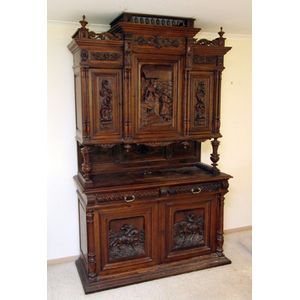Tudor Revival Oak Cabinet with Leadlight Glazing
You must be a subscriber, and be logged in to view price and dealer details.
Subscribe Now to view actual auction price for this item
When you subscribe, you have the option of setting the currency in which to display prices to $Au, $US, $NZ or Stg.
- Linenfold Carving - Linenfold carving is a carving style characterized by a pattern of vertical lines and curves that resemble folded linen or cloth. Linenfold carving was used primarily for the decoration of wood panels, which were often used for doors, furniture, and architectural elements such as wainscoting and panelling. The pattern was created by carving a series of shallow, parallel grooves into the wood, which were then smoothed and shaped to resemble folds of cloth.
- Stretcher - A horizontal rail which connects the legs of stools, chairs, tables and stands, to provide stabilisation of the legs. A stretcher table is any table with a stretcher base. The term is usually applied to substantial farmhouse tables, although many cabinetmaker's pieces, such as sofa tables, also have turned stretchers.
- Panels - Timber pieces, usually of well-figured wood either recessed or applied over the frames of doors and as decoration elsewhere in the carcase of cabinet furniture. The panels may take a variety of shapes rectangular, square, shield shape, oval, half-round or in the form of Egyptian pylons.
- Oak - Native to Europe and England, oak has been used for joinery, furniture and building since the beginning of the medieval civilisation. It is a pale yellow in colour when freshly cut and darkens with age to a mid brown colour.
Oak as a furniture timber was superceded by walnut in the 17th century, and in the 18th century by mahogany,
Semi-fossilised bog oak is black in colour, and is found in peat bogs where the trees have fallen and been preserved from decay by the bog. It is used for jewellery and small carved trinkets.
Pollard oak is taken from an oak that has been regularly pollarded, that is the upper branches have been removed at the top of the trunk, result that new branches would appear, and over time the top would become ball-like. . When harvested and sawn, the timber displays a continuous surface of knotty circles. The timber was scarce and expensive and was used in more expensive pieces of furniture in the Regency and Victorian periods.
This item has been included into following indexes:
Visually similar items

A large French oak sideboard in the Louis XIII manner, having a shaped pediment above three drawers and two panelled cupboards carved with figural medallions, shields, torches and foliate motifs above an extended lower section with three further drawers an

Antique French Renaissance style walnut six door buffet, carved in high relief with a hunting party on horse back

A Tudor revival leadlight-glazed oak cabinet, mid-20th century, the upper section with a pair of leadlight-glazed doors enclosing a mirror-backed interior with glass shelves, linenfold panels to the sides, on a low stand with a pair of drawers raised on sc

An Impressive antique French walnut Henry II style hunting buffet, carved in high relief with a central hunting scene, and various other designs, of breakfront shape, approx. cm high, cm wide, deep.
